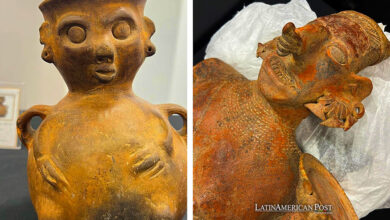Newly Discovered Similarities Between the Last Emperors of the Aztec and Inca Empires

Eduardo Matos Moctezuma’s new book explores the lives and deaths of Moctezuma II and Atahualpa, drawing parallels between the two great rulers who fell to the Spanish conquistadors.
Mexican archaeologist and writer Eduardo Matos Moctezuma, whose second surname coincidentally mirrors that of the Aztec ruler, sheds light on his latest work, Moctezuma y Atahualpa. Vida, pasión y muerte de dos gobernantes, in an interview with EFE. Co-authored with Peruvian historian Luis Millones, the book examines the lives, reigns, and tragic ends of Moctezuma II, the ninth emperor of the Aztec Empire, and Atahualpa, the last emperor of the Inca Empire. These two leaders, separated by vast distances yet united in their downfall at the hands of Spanish conquistadors, provide a poignant narrative on the impact of European colonization on indigenous civilizations in Latin America.
The Rise and Rule of Moctezuma II
Moctezuma II, born in 1466, ascended to the throne as the ninth emperor of the Aztec Empire, which was at its zenith. His reign marked a period of monumental architecture, sophisticated societal structures, and complex religious practices. Under his rule, Tenochtitlan, the Aztec capital, flourished as a center of power and culture. However, Moctezuma’s encounter with Hernán Cortés in 1519 set in motion a series of events that would lead to the empire’s collapse.
When Cortés and his men arrived, Moctezuma attempted diplomacy, sending gifts to appease the newcomers. Unfortunately, these gestures only fueled the Spaniards’ greed. As tensions escalated, Moctezuma was captured and used as a puppet by Cortés to control the Aztec population. His death on June 30, 1520, remains shrouded in mystery. Some accounts suggest the Spaniards killed him, while others claim his people stoned him during a revolt. Regardless of the exact circumstances, Moctezuma’s demise marked a pivotal moment in the fall of Tenochtitlan and the end of the Aztec Empire.
The Rise and Rule of Atahualpa
Atahualpa, born around 1502, rose to power after a bloody civil war against his brother Huáscar, becoming the last emperor of the Inca Empire in 1532. His reign, though short-lived, was marked by the same traits of power and ambition that characterized Moctezuma’s rule. The Inca Empire, renowned for its engineering feats, advanced agriculture, and intricate road network, peaked under Atahualpa’s leadership.
However, his encounter with Francisco Pizarro’s expedition in 1532 at Cajamarca would seal his fate. Despite offering a massive ransom of gold and silver in exchange for his freedom, Atahualpa was imprisoned by Pizarro. After a mock trial, he was executed by strangulation on July 26, 1533, following a baptism into Christianity. His death created a power vacuum and internal divisions within the Inca Empire, allowing the Spanish to consolidate control and ultimately conquer the vast territories that Atahualpa once ruled.
Parallels and Legacies
Matos Moctezuma elaborates on the striking parallels between Moctezuma and Atahualpa. Both emperors governed extensive territories with sophisticated social structures and cultural achievements. Their respective confrontations with Spanish conquistadors led to the collapse of their empires, and both met tragic ends that symbolized the brutal conquest and colonization of the Americas.
The idea for this book had been brewing in Matos’s mind for quite some time. During a meal with Luis Millones and his wife, the concept of comparing these two iconic figures took shape. Each author would delve into the ruler’s life from their own country, creating a narrative that not only highlights the shared experiences and ultimate fates of Moctezuma and Atahualpa but also underscores the authors’ intention to present a balanced and comprehensive view of these historical figures.
Matos explains that despite the differences in their cultures and empires, both leaders faced Spanish invaders with initial attempts at diplomacy. Moctezuma and Atahualpa offered vast amounts of gold and riches to deter the Spaniards, only to see their offers increase the conquerors’ ambitions. Both rulers were eventually captured, held as hostages, and killed when they ceased to benefit their captors.
The circumstances surrounding their deaths are still debated. In Moctezuma’s case, there are two main theories: one suggests he was killed by his people when he attempted to calm them on behalf of the Spaniards, while the other, which Matos finds more plausible, posits that he was stabbed by Cortés’s men in desperation. Atahualpa, on the other hand, was strangled by the Spaniards after being deceived by Pizarro, who reneged on his promise to release him despite receiving a substantial ransom. These tragic endings serve as a poignant reminder of the brutality of the conquest.
Enduring Cultural Impact
Initially, the book was to conclude with Moctezuma and Atahualpa’s deaths. However, Matos recognized the importance of exploring their lasting legacies. He proposed to Millones that they include a postscript detailing how these figures remain influential in Latin American culture through dances, theatrical performances, and other cultural representations.
Matos recounts that both Moctezuma and Atahualpa continue to be celebrated in various forms of popular culture across Mexico, Peru, and other parts of Latin America. These cultural practices, from dances to theatrical performances, serve as a living testament to their enduring significance and the lasting impact of their stories on the region’s collective memory. They allow us to connect with the past and understand the profound influence of these ancient leaders on our present culture.
Eduardo Matos Moctezuma’s Moctezuma y Atahualpa. Vida, pasión y muerte de dos gobernantes offers readers a profound understanding of the complexities and nuances of pre-Columbian empires. By examining the lives of these two rulers, the book provides valuable insights into the history of Latin America and the enduring influence of its ancient leaders.
The Fall of Two Great Empires
The book meticulously details the events leading up to the fall of the Aztec and Inca empires. For the Aztecs, Moctezuma’s capture by Cortés was a turning point. The Spaniards, aided by indigenous allies who opposed the Aztecs, laid siege to Tenochtitlan. Despite fierce resistance, the city fell in 1521, marking the end of the Aztec Empire.
Similarly, Atahualpa’s capture by Pizarro and his subsequent execution led to the rapid disintegration of the Inca Empire. The Spanish exploited internal divisions and used superior military technology to conquer the Incas. With its impressive infrastructure and sophisticated governance, the once-great empire fell under Spanish control.
Matos and Millones highlight that the downfall of these empires was not just due to military conquest but also to the diseases brought by the Europeans, which decimated indigenous populations. The loss of life from epidemics such as smallpox severely weakened the social and political structures of the Aztec and Inca civilizations, making them more vulnerable to conquest.
Reflections on Leadership and Resistance
The lives of Moctezuma and Atahualpa are a study of leadership during times of crisis. Both rulers faced unprecedented challenges from foreign invaders and attempted to navigate these threats through diplomacy and strategic offerings. Their efforts, however, were met with betrayal and violence, reflecting the harsh realities of colonial conquest.
Matos emphasizes the resilience of these leaders and their people. Despite their eventual defeat, the cultural and historical legacies of the Aztec and Inca empires continue to inspire pride and identity among their descendants. The book explores how modern Latin American societies remember and honor these figures, acknowledging their contributions to the region’s rich heritage.
The stories of Moctezuma and Atahualpa also serve as a reminder of the complexities of cultural exchange and the impacts of colonization. Their interactions with the Spanish highlight the profound changes that occurred during the early stages of European expansion into the Americas. These encounters set the stage for centuries of cultural blending, conflict, and adaptation.
Lessons from History
Eduardo Matos Moctezuma’s book, co-authored with Luis Millones, significantly contributes to understanding Latin American history. By drawing parallels between Moctezuma and Atahualpa, the authors provide a nuanced perspective on the experiences of two great empires faced with existential threats from Spanish conquistadors.
The detailed accounts of their reigns, their encounters with the Spanish, and their ultimate fates offer valuable lessons on leadership, resilience, and the consequences of cultural encounters. The book also underscores the importance of remembering and honoring historical figures who shaped history in the Americas.
Also read: Bolivian Qhara Qhara’s Fight for the San José Galleon’s Treasure
As Latin America continues to grapple with the legacies of colonization, the stories of Moctezuma and Atahualpa remain relevant. They are potent symbols of the region’s rich indigenous heritage and the enduring struggle for recognition and respect in a post-colonial world. Through their lives and deaths, these two emperors remind us of the importance of understanding and preserving the histories of those who came before us.





